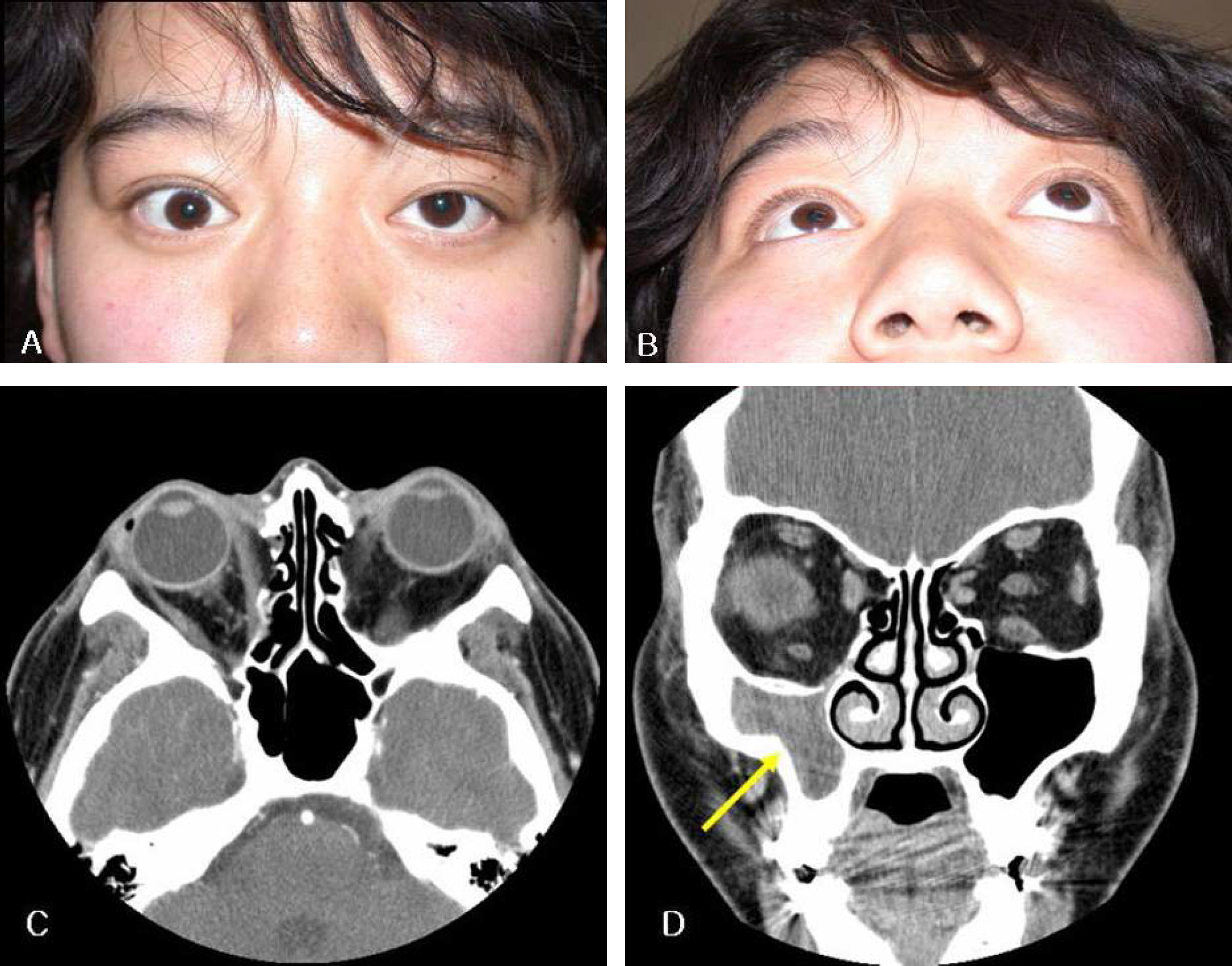J Korean Ophthalmol Soc.
2008 Feb;49(2):362-367. 10.3341/jkos.2008.49.2.362.
A Case of Imploding Antrum (Silent Sinus) Syndrome after Orbital Decompression
- Affiliations
-
- 1Department of Ophthalmology, Samsung Medical Center, Sungkyunkwan University School of Medicine, Seoul, Korea. ydkimoph@skku.edu
- 2Department of Ophthalmology, Korea Veterans Hospital, Seoul, Korea.
- KMID: 2127130
- DOI: http://doi.org/10.3341/jkos.2008.49.2.362
Abstract
-
PURPOSE: Imploding antrum (silent sinus) syndrome has clinical features of enophthalmos and hypoglobus after a downward collapse of inferior orbital wall with an ipsilateral volume decrease of maxillary sinus. We present a case of imploding antrum syndrome after an orbital decompression surgery.
CASE SUMMARY
A 26-year-old female underwent inferomedial wall orbital decompression surgery through a caruncular approach to reduce exophthalmos. At 14 months after surgery, her right eye showed 2 mm of enophthalmos and orbital CT scan revealed both maxillary sinusitis. At 28 months after surgery, 3 mm of enophthalmos and hypoglobus of the right were observed, and an orbital CT scan was taken. Orbital CT scan showed a downward collapse of inferior orbital wall, a volume decrease and inward bowing of the maxillary sinus, and a maxillary opacification on the right side, which are typical findings of imploding antrum (silent sinus) syndrome.
CONCLUSIONS
Imploding antrum (silent sinus) syndrome after orbital decompression surgery is a rare complication. Considering that any prolapsed orbital fat after orbital decompression surgery could result in imploding antrum syndrome with hypoventilation of a maxillary sinus, care should be taken to keep the maxillo-ethmoidal interface (bony strut) intact, which helps maintain maxillary aeration.
MeSH Terms
Figure
Reference
-
References
1. Mourits MP, Koornneef L, Wiersinga WM, et al. Orbital decompression for Graves' ophthalmopathy by inferomedial, by inferomedial plus lateral, and by coronal approach. Ophthalmology. 1990; 97:636–41.
Article2. Lyons CJ, Rootman J. Orbital decompression for disfiguring exophthalmos in thyroid orbitopathy. Ophthalmology. 1994; 101:223–30.
Article3. Fatourechi V, Garrity JA, Bartley GB, et al. Graves ophthalmopathy. Results of transantral orbital decompression performed primarily for cosmetic indications. Ophthalmology. 1994; 101:938–42.4. Kalmann R, Mourits MP, van der Pol JP, Koornneef L. Coronal approach for rehabilitative orbital decompression in Graves' ophthalmopathy. Br J Ophthalmol. 1997; 81:41–5.
Article5. Rose GE, Lund VJ. Clinical Features and Treatment of Late Enophthalmos after Orbital Decompression: a condition suggesting cause for idiopathic “imploding antrum” (silent sinus) syndrome. Ophthalmology. 2003; 110:819–26.6. Soparkar CN, Patrinely JR, Cuaycong MJ, et al. The silent sinus syndrome. A cause of spontaneous enophthalmos. Ophthalmology. 1994; 101:772–8.7. Rose GE, Sandy CJ, Halberg L, Moseley I. Clinical and radiological characteristics of the imploding antrum, or “silent sinus,” syndrome. Ophthalmology. 2003; 110:811–8.8. Cline RA, Rootman J. Enophthalmos: a clinical review. Ophthalmology. 1984; 91:229–37.9. Rodriguez ED, Langner RB, Manson PN. Microsurgical Enophthalmos Correction After Silent Sinus Syndrome. J Craniofac Surg. 2007; 18:454–6.
Article10. Hunt SM, Tami TA. Sinusitis-induced enophthalmos: the silent sinus syndrome. Ear Nose Throat J. 2000; 79:576. 579-81, 584.
Article11. Gillman GS, Schaitkin BM, May M. Asymptomatic enophthalmos: the silent sinus syndrome. Am J Rhinology. 1999; 13:459–62.
Article12. Audemard D, Galipienzo V, Marck E, et al. Silent sinus syndrome: a rare case of enophthalmia. J Fr Ophtalmol. 2002; 25:266–9.13. Gagnon MR, Yeatts RP, Williams Z, Matthews B. Delayed enophthalmos following a minimally displaced orbital floor fracture. Ophthal Plast Reconstr Surg. 2004; 20:241–3.
Article14. Hobbs CGL, Saunders MW, Potts MJ. “Imploding antrum” or silent sinus syndrome following naso-tracheal intubation. Br J Ophthalmol. 2004; 88:974–5.
Article15. Davidson JK, Soparkar CN, Williams JB, Patrinely JR. Negative sinus pressure and normal predisease imaging in silent sinus syndrome. Arch Ophthalmol. 1999; 117:1653–4.16. Ando A, Velasco AA. Management of enophthalmos and superior sulcus deformity induced by the silent sinus syndrome. Aesthetic Plast Surg. 2005; 29:74–7.
Article17. Goldberg RA, Shorr N, Cohen MS. The medial orbital strut in the prevention of postdecompression dystopia in dysthyroid ophthalmopathy. Ophthal Plast Reconstr Surg. 1992; 8:32–4.
Article
- Full Text Links
- Actions
-
Cited
- CITED
-
- Close
- Share
- Similar articles
-
- A Case of Orbital Apex Syndrome Caused by Mucocele in the Sphenoid Sinus
- Endoscopic Orbital Decompression for Dysthyroid Orbitopathy
- Traumatic Superior orbital fissure syndrome complicating fractures of the facial skeleton: Report of a Case
- Effect of Posterior Strut Removal during Orbital Decompression for Graves’ Orbitopathy
- Change in Quality of Life after Orbital Decompression Surgery in Patients with Dysthyroid Ophthalmopathy





